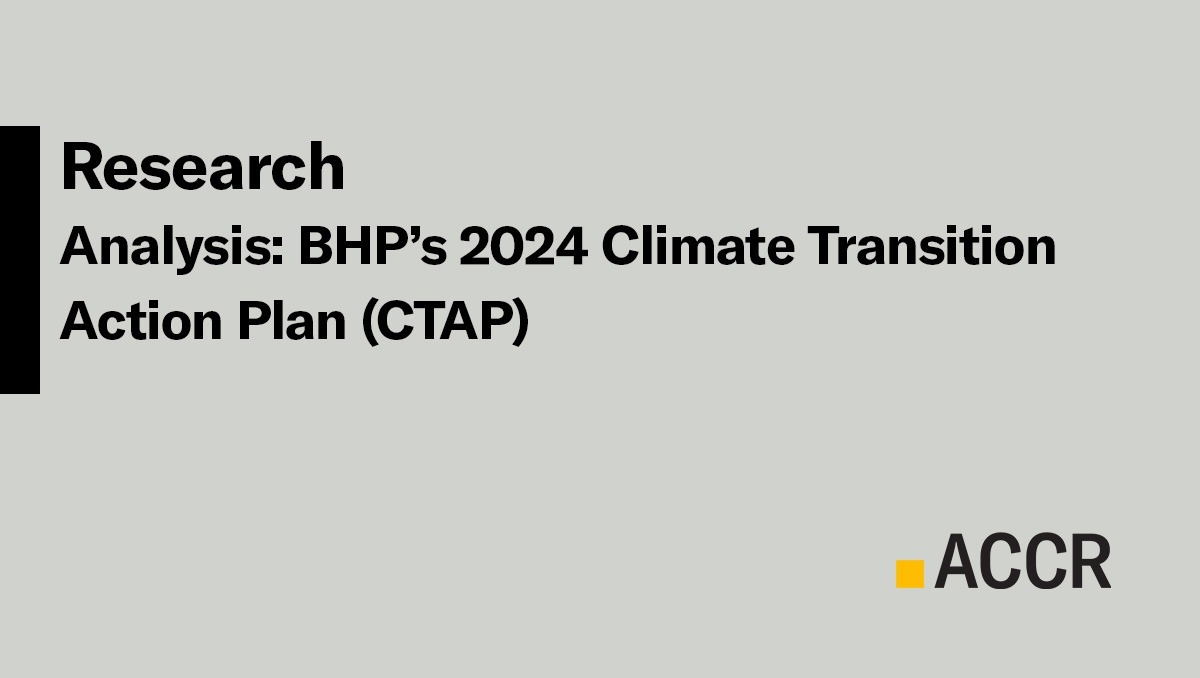Publication Analysis: BHP's 2024 Climate Transition Action Plan
Executive Summary
ACCR believes there is sufficient reason to vote against BHP’s 2024 Climate Transition Action Plan (CTAP).
BHP’s scope 3 emissions, dominated by the processing of its iron ore and metallurgical coal into steel, account for 97% of its total emissions footprint, and pose the most material risk and opportunity for investors to consider in this CTAP.
Addressing scope 3 emissions in the steel value chain and investing in green and low-carbon pathways is crucial for BHP’s positioning as global demand shifts towards green steel. While the 2024 CTAP provides improved disclosures on scope 3, it falls short on ambition and does not have a capital allocation strategy to match the scale of the challenge.
ACCR analysis also finds that BHP’s “1.5°C scenario”, which it uses to assess the resilience of its assets, downplays the transition risks the company faces and does not provide a robust assessment of portfolio resilience for investors. There is also insufficient detail on how BHP’s metallurgical coal expansion plans align with its decarbonisation strategy.
With BHP only providing a CTAP on a triennial basis, the 2024 CTAP charts the course for the next three critical years of the energy transition - underscoring the importance of ensuring that this climate plan positions BHP to remain resilient in the future low-carbon economy.
Key Points
- The 2024 CTAP improves disclosures on BHP's forward plans and investments for scope 3 emissions reductions from the steel value chain.
- Disclosed direct capital allocation towards steel decarbonisation is low: just US$75m between FY25 - FY29. Given the volume of associated scope 3 emissions and the risks it poses to BHP’s iron ore business, shareholders would likely expect to see a more ambitious commitment.
- BHP’s steel decarbonisation strategy shows a heavy reliance on blast furnace (BF-BOF) combined with CCUS, overstating the decarbonisation potential of this technology and underplaying the risks. This introduces long-term risk to BHP’s ability to meet its scope 3 targets. EAF and electric smelting technologies, which are more technologically mature and offer greater decarbonisation potential, are given lesser priority.
- The CTAP provides scant detail about how BHP’s metallurgical coal projects, particularly its expansions in Queensland, align with the company’s decarbonisation strategy and scope 3 goals. ACCR analysis suggests BHP’s forecast metallurgical coal production is significantly misaligned with the Paris Agreement.
- BHP’s planning range forecasts 2°C of warming by 2100 - a failure of the Paris Agreement - yet the CTAP doesn’t meaningfully acknowledge the material physical and financial risks of this temperature outcome, or the risks to shareholder value.
- BHP uses its own 1.5°C scenario to assess the resilience of its assets under 1.5°C of warming. ACCR analysis of this scenario finds that it significantly overestimates the role of CCUS compared to more credible, industry-standard scenarios. This approach downplays the transition risks and does not provide investors a robust assessment of portfolio resilience.
- Climate lobbying is not well integrated into the CTAP - despite increasing investor recognition that policy engagement is a critical component of transition plans, and that transition plans should disclose interdependencies between net zero targets and the wider policy environment.
Download Analysis: BHP’s 2024 Climate Transition Action Plan (CTAP) | 26/09/24
Please read the terms and conditions attached to the use of this site.
